Stability Assessment of Rock Slopes Using the Q-Slope Classification System: A Reliability Analysis Employing Case Studies in Ecuador
Abstract
:1. Introduction
- i.
- On slopes, the relationship of (Jr/Ja) is multiplied by a subfactor “O”, which considers the impact of discontinuity orientation on slope stability;
- ii.
- The Jw factor is transformed into a double parameter that analyzes the relationship between the state of the slopes and the environment in which they are located;
- iii.
- The SRF factor for slopes is divided into three potential lines of analysis depending on the existing field data: (a) physical condition, (b) stress, and (c) major discontinuity.
2. Study Sites
3. Materials and Methods
3.1. Data Acquisition
3.2. Basic Kinematic Assessment
3.3. Rock Slope Quality Assessment Using Q-slope
- RQD: Rock quality designation;
- Jn: Joint set number;
- Jr: Joint roughness number;
- Ja: Joint alteration number;
- O-factor: Orientation factor for the ratio Jr/Ja;
- Jwice: Environmental and geological condition number, which replaces the
- Joint: water reduction factor (Jw) of the original Q-index;
- SRF: Stress reduction factor for the slope. It is the maximum value between SRFa (which addresses physical condition), SRFb (which addresses stress, similarly to the one used in the Q-index); SRFc: (which considers major discontinuity).
3.4. Calculation of the Factor of Safety
3.5. Validation and Reliability of the Results (Confusion Matrix)
4. Results
- For statistical study cases a and b, 24 values are true positive values, and only 6 were classified as false positives–negatives; for statistical case c, 21 are true positive values, and 9 cases were classified as false positives–negatives.
- For case a, a 100% value was obtained in producer accuracy (precision) with the stable and quasi-stable classes–the remaining sub-classes and statistical cases produced 95% and lower values.
- Regarding user accuracy (recall), 100% values were obtained for all statistical cases with sub-class stable. Case a with sub-class failed also produced a 100% value. Other sub-classes and statistical cases registered values of 89% and lower.
- The overall accuracy parameter, which defines the quality of the result obtained for the classification method (Guan et al., 2020), provided an 80% value for statistical cases a and b and 70% for case c.
5. Discussion
6. Conclusions
Author Contributions
Funding
Institutional Review Board Statement
Informed Consent Statement
Data Availability Statement
Acknowledgments
Conflicts of Interest
References
- Barton, N.; Lien, R.; Lunde, J. Engineering Classification of Rock Masses for the Design of Tunnel Support. Rock Mech. 1974, 6, 189–236. [Google Scholar] [CrossRef]
- Bieniawski, Z.T. Engineering rock mass classifications: A complete manual for engineers and geologists in mining, civil, and petroleum engineering. In Engineering Rock Mass Classifications: A Complete Manual for Engineers and Geologists in Mining, Civil, and Petroleum Engineering; Wiley: Hoboken, NJ, USA, 1989. [Google Scholar]
- Pantelidis, L. Rock slope stability assessment through rock mass classification systems. Int. J. Rock Mech. Min. Sci. 2009, 46, 315–325. [Google Scholar] [CrossRef]
- Moon, V.; Russell, G.; Stewart, M. The value of rock mass classification systems for weak rock masses: A case example from Huntly, New Zealand. Eng. Geol. 2001, 61, 53–67. [Google Scholar] [CrossRef]
- Romana, M. New adjustment ratings for application of Bieniawski classification to slopes. In Proceedings of the International Symposium on Role of Rock Mechanics, Zacatecas, Mexico, 2–4 September 1985; pp. 49–53. Available online: https://www.scirp.org/(S(351jmbntvnsjt1aadkposzje))/reference/ReferencesPapers.aspx?ReferenceID=253061 (accessed on 16 July 2022).
- Laubscher, D.H. Geomechanics classification system for the rating of rock mass in mine design. J. S. Afr. Inst. Min. Metall. 1990, 90, 257–273. [Google Scholar] [CrossRef]
- Barton, N.; Bar, N. Introducing the Q-slope method and its intended use within civil and mining engineering projects. In Proceedings of the ISRM Regional Symposium, EUROCK 2015, Salzburg, Austria, 7–10 October 2015; pp. 157–162. [Google Scholar]
- Bar, N.; Barton, N. The Q-Slope Method for Rock Slope Engineering. Rock Mech. Rock Eng. 2017, 50, 3307–3322. [Google Scholar] [CrossRef]
- Romana, M.; Tomás, R.; Serón, J.B. Slope Mass Rating (SMR) geomechanics classification: Thirty years review. In Proceedings of the 13th ISRM International Congress of Rock Mechanics, Montreal, Canada, 10–13 May 2015; pp. 1–10. [Google Scholar]
- Tomás, R.; Romana, M.; Serón Gáñez, J.B. Review of the Current Status of the Geomechanic Classification Slope Mass Rating (SMR). Bol. Soc. Española Mecánica Suelos Ingeneiría Geotécnica 2017, 190, 25–32. Available online: http://rua.ua.es/dspace/handle/10045/70953 (accessed on 20 September 2022).
- Azarafza, M.; Nanehkaran, Y.A.; Rajabion, L.; Akgün, H.; Rahnamarad, J.; Derakhshani, R.; Raoof, A. Application of the modified Q-slope classification system for sedimentary rock slope stability assessment in Iran. Eng. Geol. 2020, 264, 105349. [Google Scholar] [CrossRef]
- Siddique, T.; Pradhan, S.P.; Vishal, V.; Singh, T.N. Applicability of Q-slope Method in the Himalayan Road Cut Rock Slopes and Its Comparison with CSMR. Rock Mech. Rock Eng. 2020, 53, 4509–4522. [Google Scholar] [CrossRef]
- Yellas, C.; Benzaid, R.; Tekkouk, M. Application of classification systems for the assessment of rock mass stability—Case of national road 43, Jijel, Algeria. Arab. J. Geosci. 2021, 14, 203. [Google Scholar] [CrossRef]
- Umrao, R.K.; Singh, R.; Ahmad, M.; Singh, T.N. Stability Analysis of Cut Slopes Using Continuous Slope Mass Rating and Kinematic Analysis in Rudraprayag District, Uttarakhand. Geomaterials 2011, 1, 79–87. [Google Scholar] [CrossRef] [Green Version]
- Siddique, T.; Masroor Alam, M.; Mondal, M.E.A.; Vishal, V. Slope mass rating and kinematic analysis of slopes along the national highway-58 near Jonk, Rishikesh, India. J. Rock Mech. Geotech. Eng. 2015, 7, 600–606. [Google Scholar] [CrossRef] [Green Version]
- Bar, N.; Barton, N.R. Empirical slope design for hard and soft rocks using Q-slope. In Proceedings of the 50th US Rock Mechanics/Geomechanics Symposium, Houston, TX, USA, 26–29 June 2016; Volume 2, pp. 1301–1308. [Google Scholar]
- Bar, N.; Barton, N. Q-slope: An empirical rock slope engineering approach in Australia. Aust. Geomech. J. 2018, 53, 73–86. [Google Scholar]
- Bar, N.; Barton, N. Rock slope design using q-slope and geophysical survey data. Period. Polytech. Civ. Eng. 2018, 62, 893–900. [Google Scholar] [CrossRef]
- Jordá-Bordehore, L. Application of Q slope to Assess the Stability of Rock Slopes in Madrid Province, Spain. Rock Mech. Rock Eng. 2017, 50, 1947–1957. [Google Scholar] [CrossRef]
- Wyllie, D.C.; Mah, C.W. Rock slope engineering: Civil and mining. In Rock Slope Engineering, 4th ed.; CRC Press: London, UK, 2017. [Google Scholar] [CrossRef]
- Hoek, E.; Bray, J. Rock Slope Engineering, 3rd ed.; Institution of Mining and Metallurgy: London, UK, 1981. [Google Scholar]
- Jorda, L.; Tomás, R.; Rodriguez, M.A.; Abellan, A. Manual de Estaciones Geomecánicas; Universidad Politécnica de Madrid: Madrid, Spain, 2016; p. 208. [Google Scholar]
- UNESCO. Galapagos Biosphere Reserve, Ecuador. 1976. Available online: https://en.unesco.org/biosphere/lac/galapagos (accessed on 16 July 2022).
- Wolf, T. Geografía y Geología de Ecuador; Brockhaus, F.A., Ed.; Leipzig: Alicante, Spain, 1892; Available online: http://files.bernardo-servin-massieu.com/200000059-af10bb00a5/tabasco.pdf (accessed on 10 January 2021).
- Jordá-Bordehore, L.; Tomás, R.; Cano, M.; Riquelme, A. Evaluación de la calidad geomecánica de taludes inestables en la zona andina mediante la aplicación de la clasificación Slope Mass Rating. In Proceedings of the 10° Simposio Nacional de Ingeniería Geotécnica, A Coruña, España, 19–21 October 2016; Volume 1, pp. 313–320. Available online: https://www.researchgate.net/publication/309611438_Evaluacion_de_la_calidad_geomecanica_de_taludes_inestables_en_la_zona_andina_mediante_la_aplicacion_de_la_clasificacion_Slope_Mass_Rating (accessed on 29 January 2021).
- Barton, N. Some new Q-value correlations to assist in site characterisation and tunnel design. Int. J. Rock Mech. Min. Sci. 2002, 39, 185–216. [Google Scholar] [CrossRef]
- Barton, N.; Grimstad, E. Tunnel and cavern support selection in Norway, based on rock mass classification with the Q-system. Nor. Tunn. Soc. 2014, 23, 39. Available online: https://www.researchgate.net/publication/321874893_Tunnel_and_cavern_support_selection_in_Norway_based_on_rock_mass_classification_with_the_Q-system (accessed on 29 January 2021).
- Bar, N.; Barton, N.R.; Ryan, C.A. Application of the Q-slope method to highly weathered and saprolitic rocks in Far North Queensland. In Proceedings of the ISRM International Symposium—EUROCK, Ürgüp, Turkey, 29–31 August 2016; Volume 1, pp. 585–590. [Google Scholar] [CrossRef]
- Rocscience. 2D and 3D Geotechnical Software | Rocscience Inc. 2019. Available online: https://www.rocscience.com (accessed on 15 June 2021).
- Mikola. Roozbeh Geraili Mikola—Codes & Demos. 2018. Available online: http://www.roozbehgm.com/codes.html (accessed on 20 September 2022).
- Visa, S.; Ramsay, B.; Ralescu, A.L.; Van Der Knaap, E. Confusion Matrix-based Feature Selection. In Proceedings of the 22nd Midwest Artificial Intelligence and Cognitive Science Conference 2011, Cincinnati, OH, USA, 16–17 April 2014; Available online: https://www.researchgate.net/publication/220833270_Confusion_Matrix-based_Feature_Selection (accessed on 19 July 2022).
- Beauxis-Aussalet, E.H.L. Simplifying the Visualization of Confusion Matrix. In Proceedings of the BNAIC—Benelux Conference on Artificial Intelligence, Nijmegen, The Netherlands, 6–7 November 2014; Available online: https://www.researchgate.net/publication/302412429_Simplifying_the_Visualization_of_Confusion_Matrix (accessed on 17 July 2022).
- Stehman, S.V. Selecting and Interpreting Measures of Thematic Classification Accuracy. Remote Sens. Environ. 1997, 62, 77–89. Available online: https://www.sciencedirect.com/science/article/pii/S0034425797000837 (accessed on 20 September 2022). [CrossRef]
- Yacouby, R.; Axman, D. Probabilistic Extension of Precision, Recall, and F1 Score for More Thorough Evaluation of Classification Models. In Proceedings of the First Workshop on Evaluation and Comparison of NLP Systems 2020, Online, November 2020; pp. 79–91. [Google Scholar]
- Hoek, E. Putting numbers to geology—An engineer’s viewpoint. Q. J. Eng. Geol. 1999, 32, 283–293. [Google Scholar] [CrossRef] [Green Version]
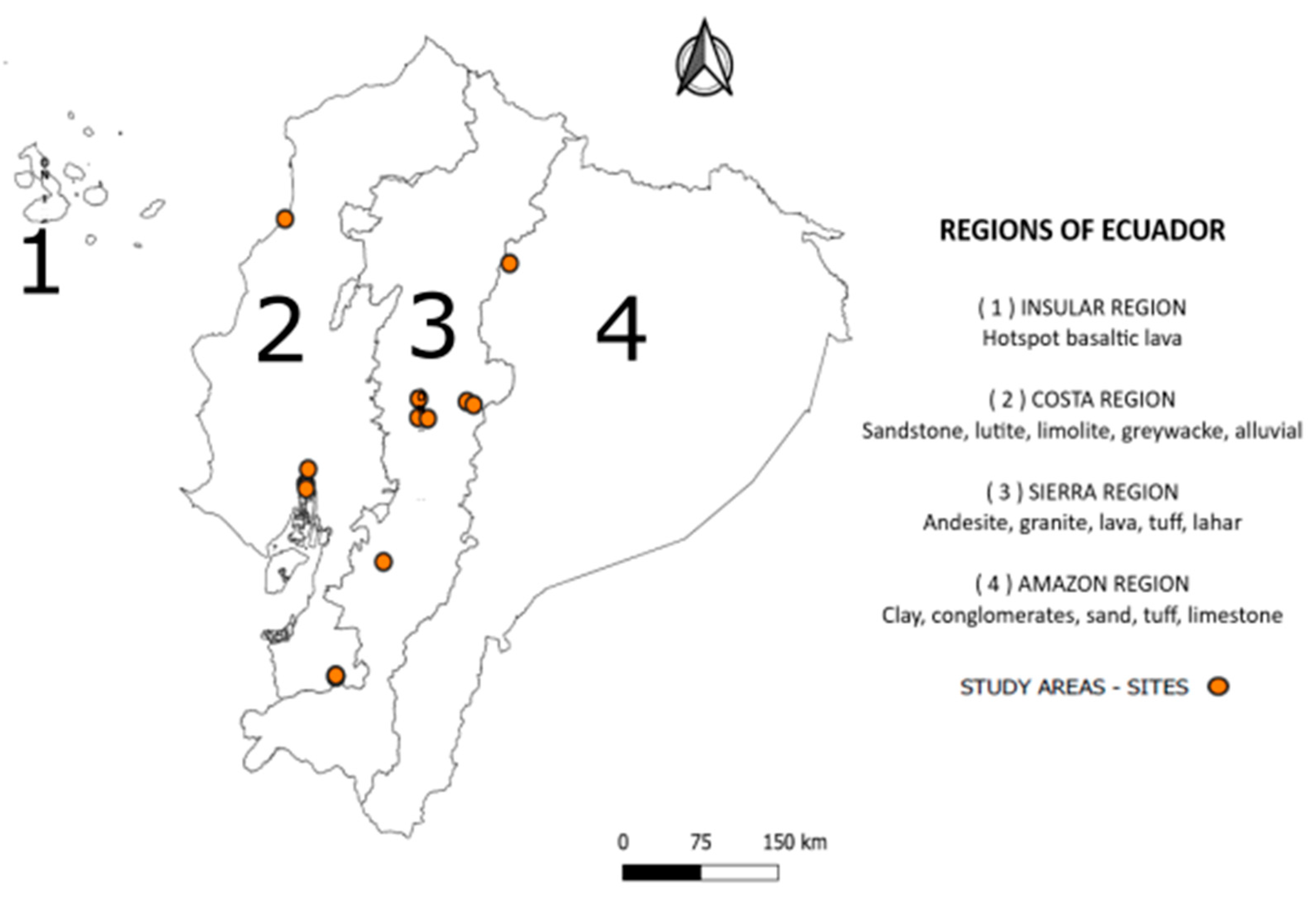
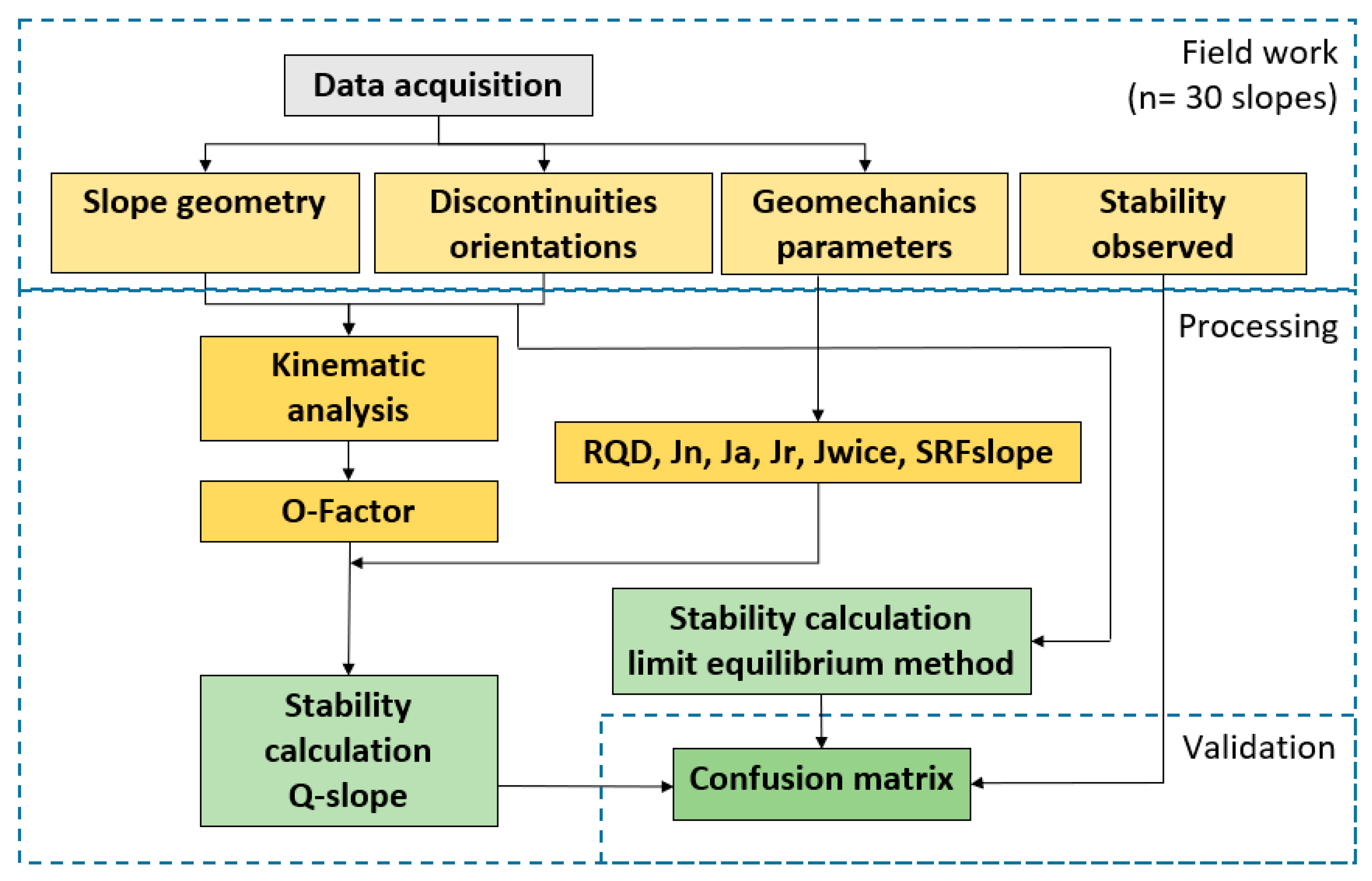
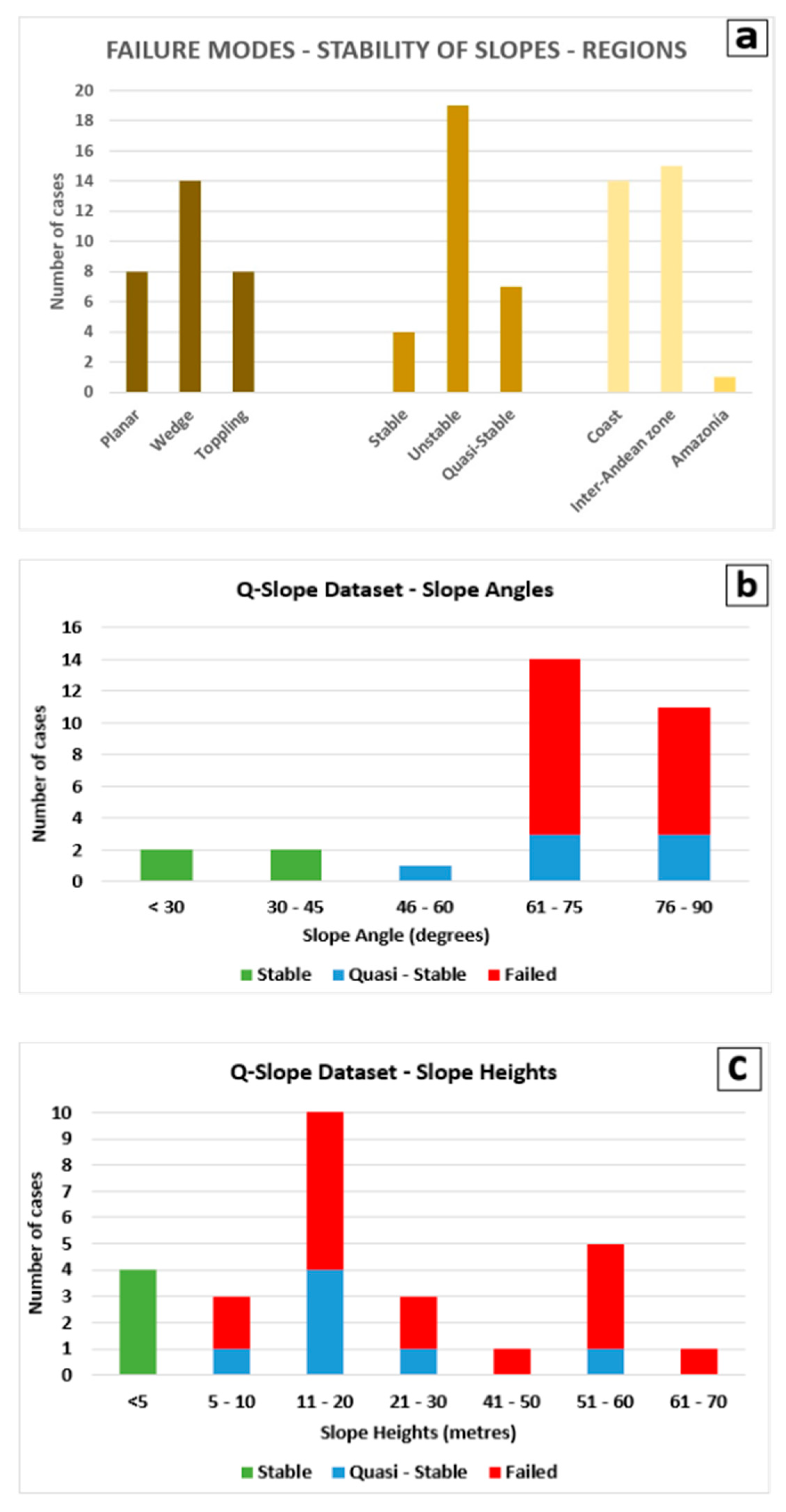
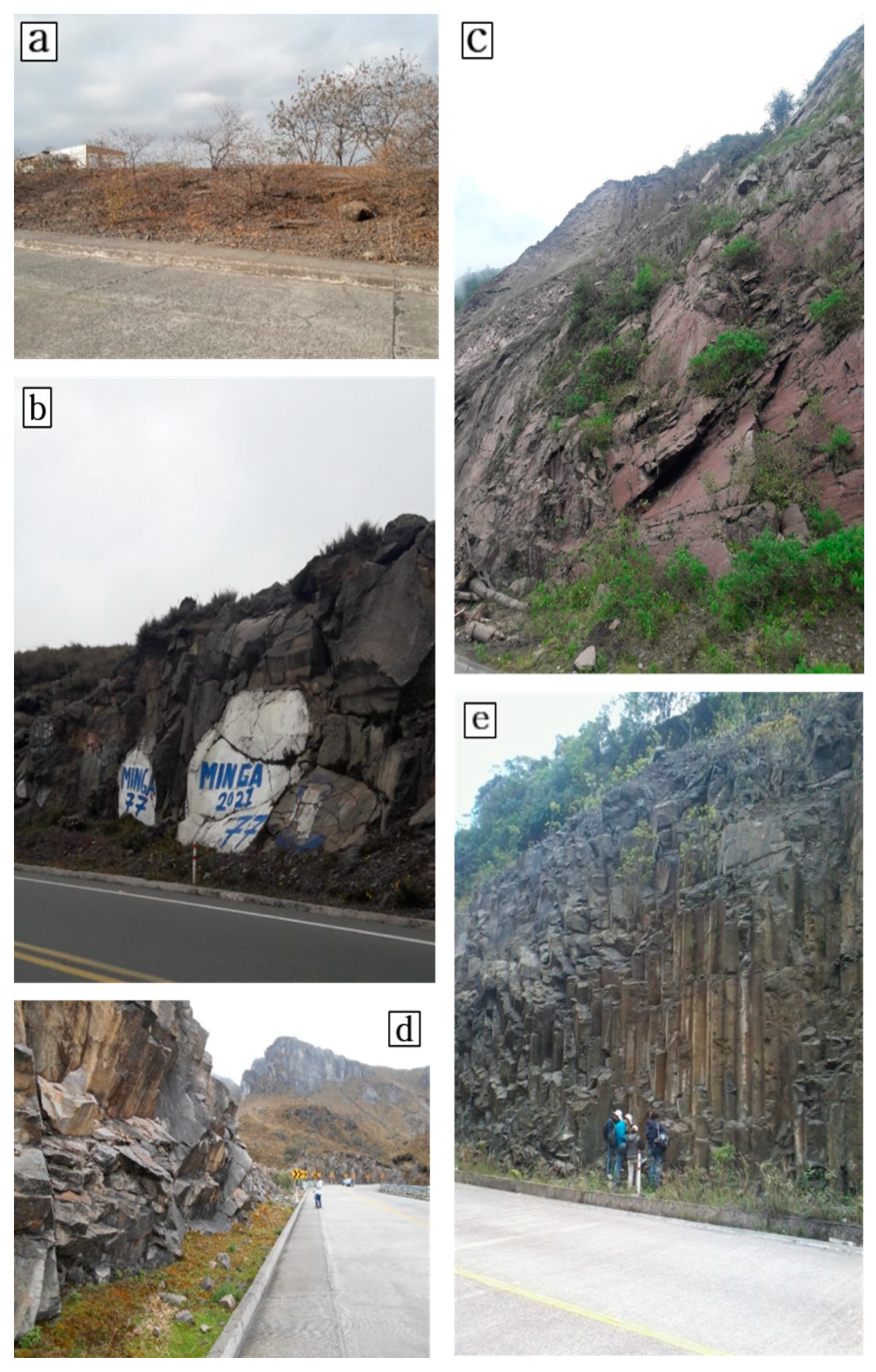

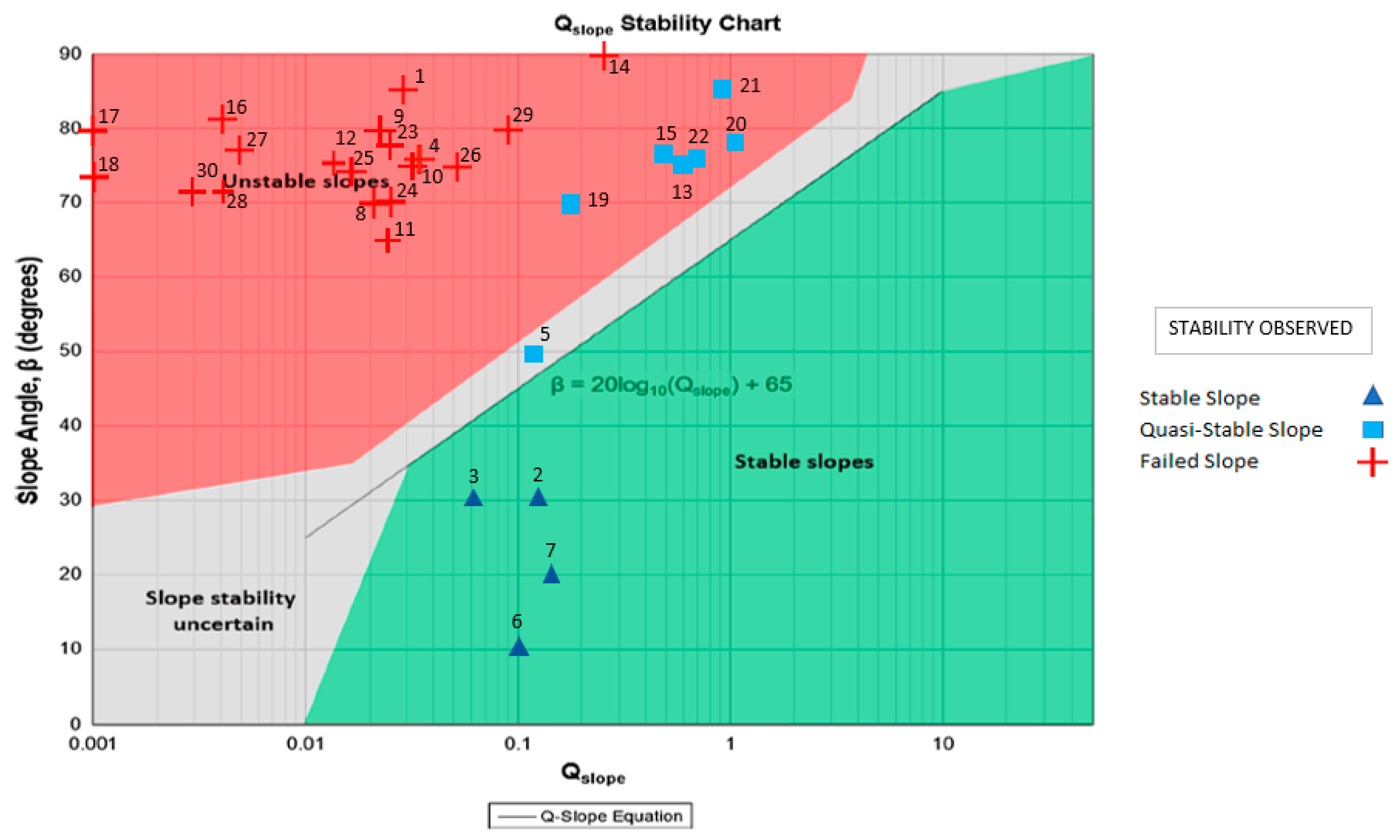
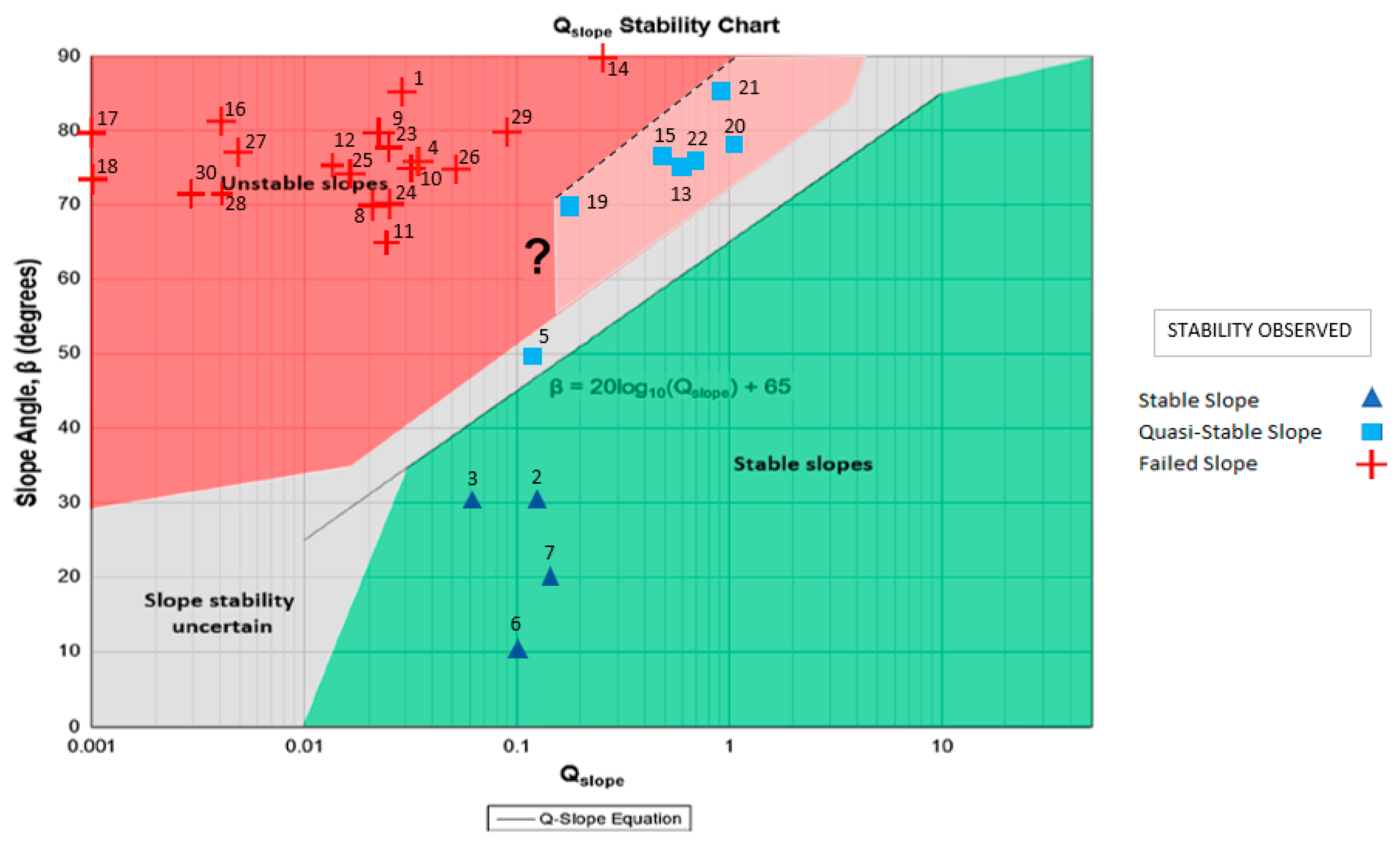
| No. | Zone of Ecuador | Province of Ecuador | Location | Use | Height in Meters | Slope Angle in Degrees | Q-Slope Value Calculation Factors | Stability Observed | Failure Mode | |||||
|---|---|---|---|---|---|---|---|---|---|---|---|---|---|---|
| RQD | Jn | (Jr/Ja)o | Jwice | SRF Slope | Q-slope Value | |||||||||
| 1 | Coast | Guayas | F. CC NN 1 | Byway | 10 | 85 | 70 | 9 | 0.759 | 0.05 | 10 | 0.030 | Unstable | Wedge |
| 2 | Coast | Guayas | F. CC NN 2 | Court | 4 | 30 | 75 | 12 | 0.750 | 0.3 | 10 | 0.141 | Stable | Planar |
| 3 | Coast | Guayas | F. CC NN 3 | Street | 4 | 30 | 65 | 12 | 0.375 | 0.3 | 10 | 0.061 | Stable | Toppling |
| 4 | Coast | Guayas | Las Aguas * | Street | 15 | 75 | 90 | 12 | 0.563 | 0.075 | 10 | 0.032 | Unstable | Toppling |
| 5 | Coast | Guayas | Bellavista | Street | 18 | 50 | 60 | 15 | 0.375 | 0.7 | 8 | 0.131 | Q-stable | Planar |
| 6 | Coast | Guayas | Santa Rosa | Quarry | 2 | 10 | 98 | 12 | 0.375 | 0.5 | 15 | 0.102 | Stable | Toppling |
| 7 | Coast | Guayas | Santa Rosa | Quarry | 3 | 20 | 99 | 12 | 0.375 | 0.5 | 10 | 0.155 | Stable | Toppling |
| 8 | Coast | Manabí | Coaque–S.Teresa | Avenue | 12 | 70 | 80 | 15 | 0.044 | 0.7 | 8 | 0.020 | Unstable | Wedge |
| 9 | Andean | Chimborazo | Cahuají–Cotaló 1 | Avenue | 60 | 80 | 90 | 15 | 0.075 | 0.5 | 10 | 0.023 | Unstable | Wedge |
| 10 | Andean | Chimborazo | Cahuají–Cotaló 2 | Avenue | 55 | 75 | 90 | 12 | 0.083 | 0.5 | 10 | 0.031 | Unstable | Planar |
| 11 | Andean | Chimborazo | Cahuají–Cotaló 3 | Avenue | 60 | 65 | 95 | 12 | 0.063 | 0.5 | 10 | 0.025 | Unstable | Wedge |
| 12 | Andean | Chimborazo | Cahuají–Cotaló 4 | Avenue | 70 | 75 | 95 | 12 | 0.038 | 0.5 | 10 | 0.015 | Unstable | Wedge |
| 13 | Andean | Chimborazo | Cascada | Fairway | 60 | 75 | 95 | 12 | 0.563 | 0.7 | 5 | 0.623 | Q-stable | Planar |
| 14 | Amazon | Napo | Papallacta | Avenue | 18 | 90 | 90 | 15 | 0.380 | 0.6 | 5 | 0.270 | Unstable | Toppling |
| 15 | Andean | Azuay | El Cajas | Avenue | 13 | 77 | 100 | 9 | 0.380 | 0.6 | 5 | 0.500 | Q-stable | Planar |
| 16 | Coast | El Oro | La Mesa 1 | Quarry | 50 | 82 | 75 | 15 | 0.150 | 0.05 | 10 | 0.004 | Unstable | Toppling |
| 17 | Coast | El Oro | La Mesa 2 | Quarry | 60 | 80 | 30 | 12 | 0.056 | 0.05 | 10 | 0.001 | Unstable | Wedge |
| 18 | Coast | El Oro | La Mesa 3 | Quarry | 25 | 74 | 55 | 15 | 0.100 | 0.05 | 15 | 0.001 | Unstable | Toppling |
| 19 | Coast | El Oro | Pache-Piñas | Avenue | 17 | 70 | 100 | 12 | 0.380 | 0.3 | 5 | 0.190 | Q-stable | Wedge |
| 20 | Coast | El Oro | Pacha–Ayapamba 1 | Avenue | 15 | 78 | 85 | 15 | 6.075 | 0.3 | 10 | 1.033 | Q-stable | Wedge |
| 21 | Coast | El Oro | Pacha–Ayapamba 2 | Avenue | 25 | 85 | 80 | 15 | 6.075 | 0.3 | 10 | 0.972 | Q-stable | Wedge |
| 22 | Andean | Bolívar | Ambato–Guaranda 1 | Highway | 10 | 75 | 95 | 9 | 0.750 | 0.9 | 10 | 0.713 | Q-stable | Planar |
| 23 | Andean | Bolívar | Ambato–Guaranda 2 | Highway | 18 | 77 | 65 | 15 | 0.083 | 0.7 | 10 | 0.025 | Unstable | Planar |
| 24 | Andean | Bolívar | San Juan 1 | Avenue | 15 | 70 | 60 | 12 | 0.169 | 0.3 | 10 | 0.025 | Unstable | Wedge |
| 25 | Andean | Bolívar | San Juan 2 | Avenue | 10 | 75 | 80 | 12 | 0.125 | 0.2 | 10 | 0.017 | Unstable | Toppling |
| 26 | Andean | Bolívar | San Juan 3 | Avenue | 12 | 75 | 90 | 12 | 0.225 | 0.3 | 10 | 0.051 | Unstable | Wedge |
| 27 | Andean | Bolívar | Cashisagua 1 | Avenue | 17 | 77 | 80 | 12 | 0.025 | 0.3 | 10 | 0.005 | Unstable | Wedge |
| 28 | Andean | Bolívar | Cashisagua 2 | Avenue | 20 | 72 | 85 | 12 | 0.019 | 0.3 | 10 | 0.004 | Unstable | Wedge |
| 29 | Andean | Bolívar | Cashisagua 3 | Avenue | 30 | 80 | 95 | 12 | 0.375 | 0.3 | 10 | 0.089 | Unstable | Planar |
| 30 | Andean | Bolívar | Gallo Rumi | Avenue | 12 | 72 | 50 | 15 | 0.050 | 0.2 | 10 | 0.003 | Unstable | Wedge |
| No. | Zone of Ecuador | Slope Dip | Slope Dip Direction DipDir | Failure Mode | Joint DipDir | Joint Dip | Joint 2 DipDir (Wedges) | Frictional Component FC (Degrees) | Factor of Safety FS | Stability Factor of Safety |
|---|---|---|---|---|---|---|---|---|---|---|
| 1 | Coast | 85 | 060 | Wedge | 072 | 65 | 023 | 48 | 0.27 | Unstable |
| 2 | Coast | 30 | 035 | Planar | 030 | 73 | 37 | >1 | Stable | |
| 3 | Coast | 30 | 215 | Toppling | 192 | 16 | 37 | >2 | Stable | |
| 4 | Coast | 75 | 180 | Toppling | 187 | 15 | 37 | >3 | Stable | |
| 5 | Coast | 50 | 192 | Planar | 180 | 44 | 30 | 0.6 | Unstable | |
| 6 | Coast | 10 | 208 | Toppling | 203 | 17 | 21 | >1 | Stable | |
| 7 | Coast | 20 | 345 | Toppling | 336 | 34 | 21 | >2 | Stable | |
| 8 | Coast | 70 | 110 | Wedge | 034 | 60 | 140 | 30 | 0.73 | Unstable |
| 9 | Andean | 80 | 090 | Wedge | 155 | 77 | 077 | 11 | 0.25 | Unstable |
| 10 | Andean | 75 | 095 | Planar | 108 | 77 | 25 | >1 | Stable | |
| 11 | Andean | 65 | 090 | Wedge | 034 | 62 | 117 | 30 | 0.61 | Unstable |
| 12 | Andean | 75 | 115 | Wedge | 151 | 61 | 048 | 30 | 0.51 | Unstable |
| 13 | Andean | 75 | 180 | Planar | 186 | 49 | 37 | 0.5 | Unstable | |
| 14 | Amazon | 90 | 210 | Toppling | 065 | 80 | 30 | 0.23 | Unstable | |
| 15 | Andean | 77 | 161 | Planar | 175 | 31 | 32 | >1 | Stable | |
| 16 | Coast | 82 | 050 | Toppling | 056 | 82 | 11 | 0.33 | Unstable | |
| 17 | Coast | 80 | 325 | Wedge | 289 | 88 | 038 | 5 | 0.77 | Unstable |
| 18 | Coast | 74 | 272 | Toppling | 272 | 78 | 11 | 0.58 | Unstable | |
| 19 | Coast | 70 | 126 | Wedge | 203 | 85 | 105 | 29 | >1 | Stable |
| 20 | Coast | 78 | 137 | Wedge | 163 | 71 | 063 | 32 | 0.4 | Unstable |
| 21 | Coast | 85 | 145 | Wedge | 139 | 84 | 184 | 30 | 0.31 | Unstable |
| 22 | Andean | 75 | 060 | Planar | 062 | 79 | 37 | >1 | Stable | |
| 23 | Andean | 77 | 120 | Planar | 105 | 76 | 9 | 0.14 | Unstable | |
| 24 | Andean | 70 | 040 | Wedge | 345 | 43 | 272 | 14 | 0.62 | Unstable |
| 25 | Andean | 75 | 020 | Toppling | 010 | 63 | 14 | 0.59 | Unstable | |
| 26 | Andean | 75 | 028 | Wedge | 113 | 44 | 004 | 40 | 0.83 | Unstable |
| 27–28 | Andean | 72 | 005 | Wedge | 309 | 71 | 009 | 20 | 0.33 | Unstable |
| 29 | Andean | 80 | 080 | Planar | 099 | 77 | 37 | 0.13 | Unstable | |
| 30 | Andean | 72 | 015 | wedge | 310 | 77 | 093 | 7 | 1.16 | Stable |
| Statistical Case a: Predicted Class (Q-slope) Compared to Observed Class | |||||||
|---|---|---|---|---|---|---|---|
| Sub-Class | n (Truth Overall) | n (Classified) | Accuracy | Precision | Recall | F1 Score | Overall Accuracy |
| 1 | 4 | 4 | 100% | 1.00 | 1.00 | 1.00 | 80% |
| 2 | 7 | 1 | 80% | 1.00 | 0.14 | 0.25 | |
| 3 | 19 | 25 | 80% | 0.76 | 1.00 | 0.86 | |
| Statistical Case b: Predicted Class (FoS) Compared to Predicted Class (Q-slope) | |||||||
| Sub-Class | n (Truth Overall) | n (Classified) | Accuracy | Precision | Recall | F1 Score | Overall Accuracy |
| 1 | 4 | 9 | 83.33% | 0.44 | 1.00 | 0.62 | 80% |
| 2 | 1 | 0 | 96.67% | 0.00 | 0.00 | 0.00 | |
| 3 | 25 | 21 | 80.00% | 0.95 | 0.80 | 0.87 | |
| Statistical Case c: Predicted Class (FoS) Compared to Observed Class | |||||||
| Sub-Class | n (Truth Overall) | n (Classified) | Accuracy | Precision | Recall | F1 Score | Overall Accuracy |
| 1 | 4 | 9 | 83.33% | 0.44 | 1.00 | 0.62 | 70% |
| 2 | 7 | 0 | 76.67% | 0.00 | 0.00 | 0.00 | |
| 3 | 19 | 21 | 80.00% | 0.81 | 0.89 | 0.85 | |
Disclaimer/Publisher’s Note: The statements, opinions and data contained in all publications are solely those of the individual author(s) and contributor(s) and not of MDPI and/or the editor(s). MDPI and/or the editor(s) disclaim responsibility for any injury to people or property resulting from any ideas, methods, instructions or products referred to in the content. |
© 2023 by the authors. Licensee MDPI, Basel, Switzerland. This article is an open access article distributed under the terms and conditions of the Creative Commons Attribution (CC BY) license (https://creativecommons.org/licenses/by/4.0/).
Share and Cite
Borja Bernal, C.; Laín, R.; Jordá, L.; Cano, M.; Riquelme, A.; Tomás, R. Stability Assessment of Rock Slopes Using the Q-Slope Classification System: A Reliability Analysis Employing Case Studies in Ecuador. Appl. Sci. 2023, 13, 7399. https://doi.org/10.3390/app13137399
Borja Bernal C, Laín R, Jordá L, Cano M, Riquelme A, Tomás R. Stability Assessment of Rock Slopes Using the Q-Slope Classification System: A Reliability Analysis Employing Case Studies in Ecuador. Applied Sciences. 2023; 13(13):7399. https://doi.org/10.3390/app13137399
Chicago/Turabian StyleBorja Bernal, Cesar, Ricardo Laín, Luis Jordá, Miguel Cano, Adrián Riquelme, and Roberto Tomás. 2023. "Stability Assessment of Rock Slopes Using the Q-Slope Classification System: A Reliability Analysis Employing Case Studies in Ecuador" Applied Sciences 13, no. 13: 7399. https://doi.org/10.3390/app13137399
APA StyleBorja Bernal, C., Laín, R., Jordá, L., Cano, M., Riquelme, A., & Tomás, R. (2023). Stability Assessment of Rock Slopes Using the Q-Slope Classification System: A Reliability Analysis Employing Case Studies in Ecuador. Applied Sciences, 13(13), 7399. https://doi.org/10.3390/app13137399











